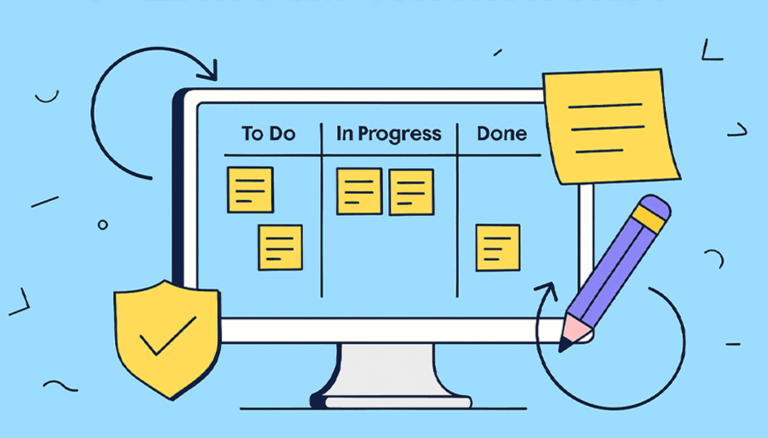Sprint Planning is the cornerstone of successful agile project delivery, yet many teams struggle to make these sessions truly effective. In this comprehensive guide, we’ll walk you through everything you need to know about Sprint Planning, from fundamental concepts to advanced implementation strategies. Whether you’re new to Scrum or looking to optimize your existing process, you’ll find actionable insights to transform your Sprint Planning sessions into productive, engaging meetings that set your team up for success.
What is Sprint Planning and Why Does it Matter?
Sprint Planning stands as the cornerstone of successful agile project delivery, serving as the crucial first event of every sprint. Think of it as your team’s GPS system – it not only shows you where you’re going but helps you plan the most efficient route to get there. During this essential ceremony, the entire Scrum Team comes together to define clear objectives and create a realistic plan for the upcoming sprint.
The significance of Sprint Planning extends beyond simple task allocation. It’s where your team:
– Aligns on sprint goals and priorities
– Builds shared understanding of upcoming work
– Creates realistic commitments based on capacity
– Sets the foundation for sprint success
The Three Pillars of Effective Sprint Planning
1. Defining Sprint Value
Your Product Owner plays a pivotal role in communicating why the upcoming sprint matters. They work with the team to establish a clear Sprint Goal that:
– Provides direction and purpose
– Aligns with broader product objectives
– Motivates team members to deliver value
2. Scope Definition
The development team carefully selects Product Backlog items that will contribute to the Sprint Goal. This selection process considers:
– Team velocity and capacity
– Technical dependencies
– Definition of Done criteria
3. Execution Strategy
With selected items in hand, the team creates a detailed plan for delivery, breaking down complex work into manageable tasks and identifying potential obstacles early.
Common Challenges and How to Overcome Them
Even experienced teams encounter obstacles during Sprint Planning. Here are the most common challenges and proven strategies to address them:
Overambitious Commitments
Many teams fall into the trap of taking on too much work. Combat this by:
– Reviewing historical velocity data
– Accounting for team capacity and upcoming events
– Using data-driven insights to make realistic commitments
Poor Backlog Preparation
Insufficient backlog refinement can derail your planning session. Prevent this by:
– Conducting regular backlog refinement sessions
– Ensuring stories are properly sized and detailed
– Having clear acceptance criteria before planning
Unclear Goals and Expectations
Without clear direction, teams can struggle to make effective decisions. Address this by:
– Establishing explicit Sprint Goals
– Defining success criteria upfront
– Maintaining focus on delivering value
The Two-Part Structure of Sprint Planning
Sprint Planning isn’t just one continuous discussion – it’s strategically divided into two distinct parts, each serving a specific purpose in setting your team up for success.
Part 1: Defining the “What”
The first part of Sprint Planning focuses on selecting and understanding the work that needs to be done. During this phase:
– The Product Owner presents the highest-priority Product Backlog items
– The team discusses and clarifies requirements
– A clear Sprint Goal is established to provide direction and purpose
– The team selects items they believe they can complete within the sprint
Part 2: Determining the “How”
Once the work is selected, the team shifts focus to execution planning:
– Breaking down complex items into manageable tasks
– Identifying technical dependencies and potential obstacles
– Creating detailed implementation strategies
– Estimating effort required for each task
Key Roles and Their Responsibilities
Understanding who does what in Sprint Planning is crucial for its success. Here’s how each role contributes:
Product Owner:
– Arrives with a well-refined Product Backlog
– Clarifies requirements and acceptance criteria
– Helps prioritize work based on business value
– Ensures the Sprint Goal aligns with product vision
Scrum Master:
– Facilitates the meeting and keeps discussions focused
– Ensures the team stays within the timebox
– Helps resolve any blockers or concerns
– Guards against overcommitment
Development Team:
– Actively participates in work selection
– Provides technical insights and feasibility assessments
– Creates the tactical plan for delivery
– Makes final commitments based on capacity
Step-by-Step Guide to Running Effective Sprint Planning
Now that we understand the essential components of Sprint Planning, let’s dive into the practical steps of running these meetings effectively. Whether you’re new to facilitating Sprint Planning or looking to enhance your current process, this comprehensive guide will help you transform your planning sessions into productive, engaging meetings that set your team up for success.
Before the Meeting: Setting the Stage for Success
The success of your Sprint Planning meeting often depends on the groundwork you lay before it begins. Here’s how to prepare effectively:
1. Pre-Planning Checklist
□ Schedule the meeting (2-4 hours for 2-week sprints)
□ Book appropriate meeting space or virtual platform
□ Ensure Product Backlog is refined and prioritized
□ Review team capacity and upcoming commitments
□ Prepare and distribute agenda to all participants
□ Gather data from previous sprint performance
2. Create a Clear Meeting Agenda
Your agenda should follow this proven structure:
First Hour: Sprint Goal and Context
– Review previous sprint outcomes (15 minutes)
– Present sprint objectives and business context (15 minutes)
– Define and align on Sprint Goal (30 minutes)
Second Hour: Backlog Selection and Scope
– Review top priority Product Backlog items (30 minutes)
– Discuss and clarify requirements (30 minutes)
Final Hours: Planning and Commitment
– Break down selected items into tasks (45 minutes)
– Estimate effort and confirm capacity (30 minutes)
– Final commitment and team alignment (15 minutes)
Sprint Planning Best Practices and Pitfall Prevention
Even the most experienced Agile teams can stumble during Sprint Planning if they’re not careful. In this section, we’ll explore proven best practices that will help your team avoid common pitfalls and ensure your Sprint Planning sessions are both efficient and effective. Whether you’re struggling with backlog refinement or finding it challenging to maintain team engagement, these practical strategies will help you transform your planning process.
The Foundation: Preparation is Everything
Think of Sprint Planning like preparing for a important journey – the better your preparation, the smoother your trip will be. Let’s explore the essential preparation steps that set you up for success.
Pre-Sprint Planning Checklist
Before diving into your Sprint Planning session, ensure you’ve completed these crucial preparation steps:
PREPARATION CHECKLIST
✓ Refine and prioritize Product Backlog
✓ Review team velocity and capacity
✓ Gather stakeholder input and feedback
✓ Prepare preliminary Sprint Goal options
✓ Schedule appropriate meeting duration
✓ Set up necessary tools and resources
Mastering Backlog Refinement
The secret to smooth Sprint Planning lies in maintaining a well-refined backlog. Here’s how to make your backlog work for you, not against you:
The DEEP Approach to Backlog Management
– Detailed appropriately: Items at the top should have enough detail for immediate implementation
– Estimated: Each item should have a clear size or complexity estimate
– Emergent: Allow the backlog to evolve based on new information and feedback
– Prioritized: Items should be ordered by business value and urgency
Implementing Effective Sprint Planning in Your Team
Throughout this guide, we’ve explored the fundamentals, components, and best practices of Sprint Planning. Now it’s time to put everything together and implement these insights in your team. This final section will provide you with practical steps, success metrics, and strategies for continuous improvement to help your team excel at Sprint Planning.
Getting Started: Your Implementation Roadmap
The journey to effective Sprint Planning doesn’t happen overnight, but with the right approach, you can transform your team’s planning process within a few sprints. Here’s your roadmap to success:
Phase 1: Foundation (Weeks 1-2)
– Establish basic Sprint Planning structure
– Implement essential ceremonies
– Set up tracking tools and metrics
Phase 2: Optimization (Weeks 3-4)
– Refine processes based on team feedback
– Address early challenges
– Enhance stakeholder engagement
Phase 3: Mastery (Weeks 5+)
– Fine-tune practices
– Measure and celebrate improvements
– Share successes and learnings
Measuring Success: Key Metrics That Matter
To ensure your Sprint Planning efforts are paying off, focus on these critical metrics:
SUCCESS METRICS DASHBOARD
1. Sprint Completion Rate – Target: 85-95% completion of committed items
2. Planning Accuracy – Target: <15% variance from estimates
3. Team Satisfaction – Target: >8/10 on team surveys
4. Stakeholder Engagement – Target: >90% attendance at reviews
Streamline Your Sprint Planning with NASA – The Ultimate Agile Solution
After mastering the principles and practices of effective Sprint Planning, the next step is to ensure your team has the right tools to execute flawlessly. This is where NASA (Not Another Stand-Up App) comes in – a powerful solution designed to address the challenges we’ve discussed throughout this guide.

How NASA Enhances Your Sprint Planning Process
NASA seamlessly integrates with your existing workflow while solving common Sprint Planning pain points:
– Automated Meeting Management: Streamline your Sprint Planning sessions with intelligent agenda management and time-boxing features
– Real-Time Collaboration: Enable seamless participation for both co-located and remote team members
– Interactive Backlog Management: Keep your Product Backlog refined and ready for planning with intuitive refinement tools
– Progress Tracking: Monitor sprint progress
Why Teams Love NASA
NASA isn’t just another tool – it’s your partner in achieving Sprint Planning Meeting excellence:
“NASA transformed our Sprint Planning sessions from chaotic meetings into focused, productive discussions. The automated features and intuitive interface have saved us hours each sprint while improving our planning accuracy.” – Sarah Chen, Scrum Master
Getting Started with NASA
Ready to take your Sprint Planning to the next level? NASA offers:
– Quick setup and team onboarding
– Integration with Jira and Confluence
– Customizable templates and workflows
– Comprehensive training resources
– Dedicated support team
Don’t let inefficient Sprint Planning hold your team back. Discover how NASA can transform your agile ceremonies and boost your team’s productivity. Try NASA Free for 30 Days →




